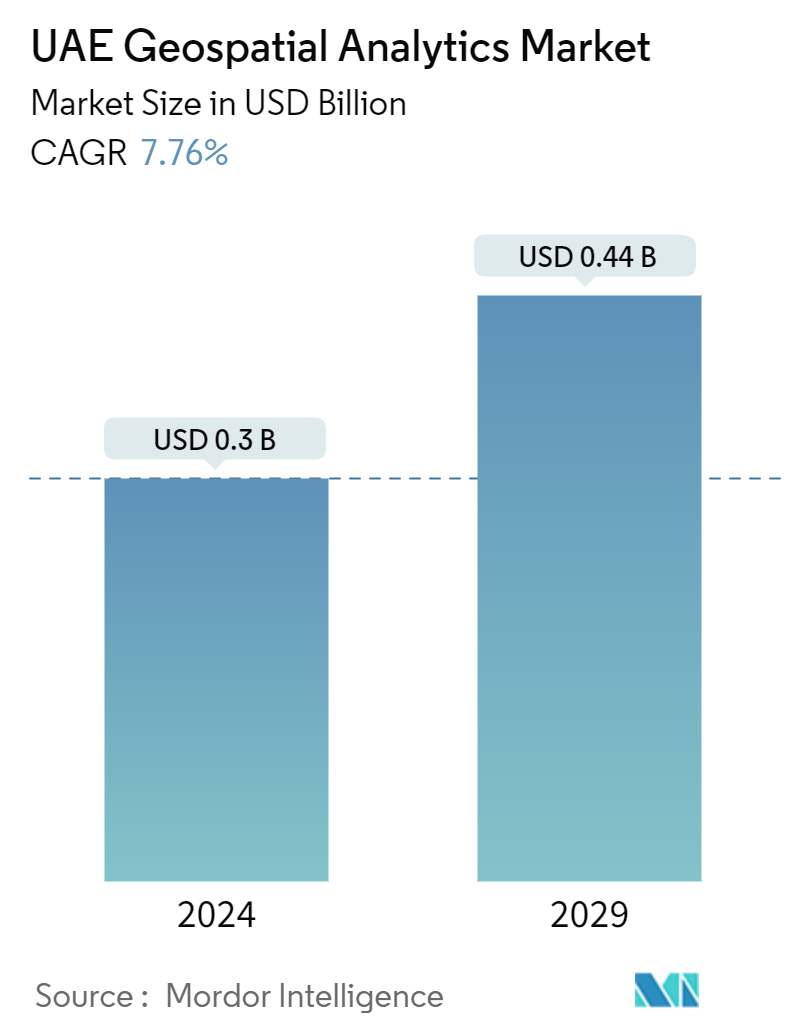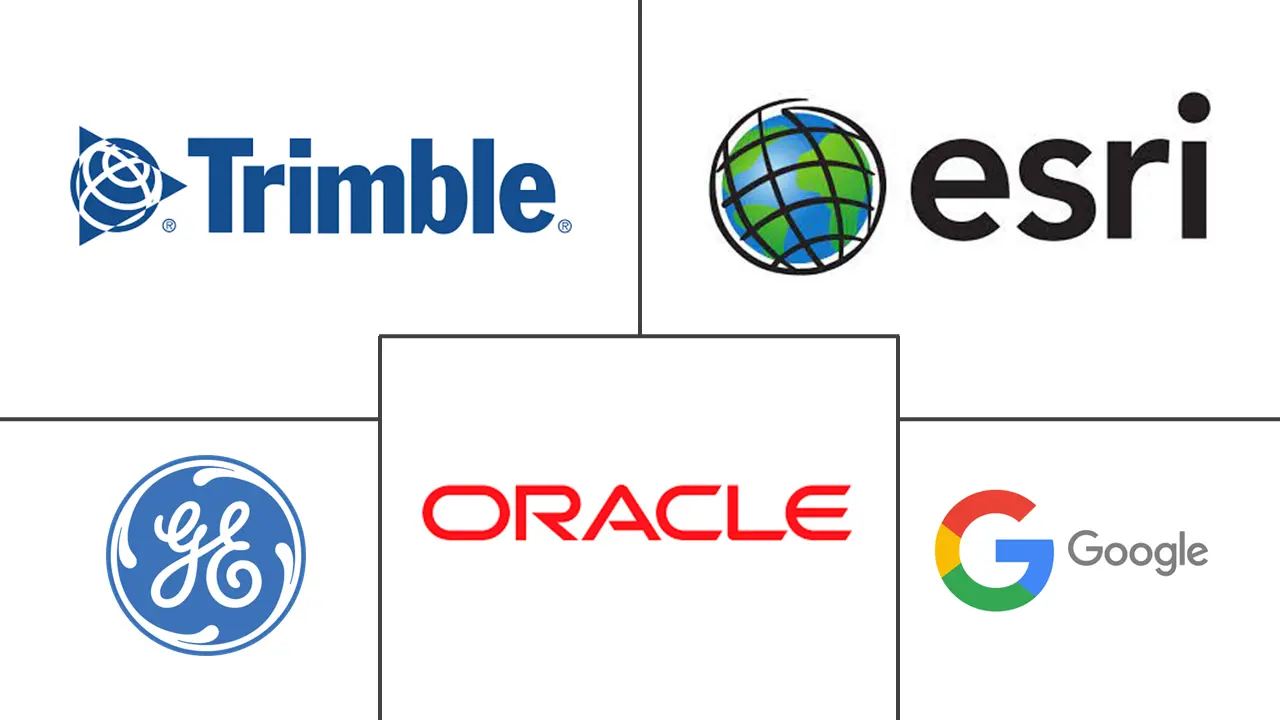Market Size of UAE Geospatial Analytics Industry

| Study Period | 2019 - 2029 |
| Base Year For Estimation | 2023 |
| Market Size (2024) | USD 0.3 Billion |
| Market Size (2029) | USD 0.44 Billion |
| CAGR (2024 - 2029) | 7.76 % |
| Market Concentration | Medium |
Major Players
*Disclaimer: Major Players sorted in no particular order |
UAE Geospatial Analytics Market Analysis
The UAE Geospatial Analytics Market size is estimated at USD 0.3 billion in 2024, and is expected to reach USD 0.44 billion by 2029, growing at a CAGR of 7.76% during the forecast period (2024-2029).
Geospatial analysis refers to a broad range of activities that emphasize applying various techniques to data comprising geographical or space-related characteristics. The increasing use of GPS devices, technological advancements in the field of GIS technology, recent trends in the integration and convergence of geospatial technologies, the emergence of new business models aimed at leveraging the demand for geospatial information, and the increased application of geospatial analytics in city and town planning are some of the primary factors driving the expansion of the market for geospatial analytics.
- Geospatial analytics may be helpful in construction. Builders and developers may make educated decisions based on data-driven insights about location, zoning, and available resources using Geographic Information Systems (GIS) tools. GIS technology may help with anything from site selection to project management in home development. GIS, for example, may be used to analyze the terrain of a possible construction site to assess its suitability for development. Furthermore, GIS may assist builders in identifying potential environmental dangers that must be considered during development.
- In October 2022, Dubai Municipality has secured two contracts with Ordnance Survey, the United Kingdom's national mapping agency, to get access to global geospatial knowledge and assist teams in monitoring activities, construction permits, survey services, executive planning, and geographic information systems. The partnership with Dubai Municipality will last a year, during which we will assess, develop, and implement a sustainable roadmap that will allow the municipality to successfully complete the transformational process and provide better services to its clients in the building and construction sectors, both public and private.
- A recent case of the use of machine learning for the geospatial analysis includes the Miami-Dade Country. Esri collaborated with NVIDIA to use deep learning and automate the manually-intensive process of creating complex 3D building models from aerial LiDAR data for Miami-Dade County.
- Geospatial artificial intelligence (geoAI) is an emerging scientific discipline that combines innovations in spatial science, artificial intelligence methods in machine learning (e.g., deep learning), data mining, and high-performance computing to extract knowledge from big spatial data.
- Implementing new technology, on the other hand, introduces new issues, such as privacy concerns, as in the case of GIS and other mapping technologies. Several times, obtaining geographical data has attracted the wrath of regional privacy and demography legislation. In order for end users to profit, new technologies need to be adopted and integrated into social discourse.
- However, several government organizations have been extremely careful regarding data "democratization,", particularly in the case of important equipment. The societal responses to privacy problems that have arisen as a result of the combination of GIS and GPS have been largely mixed. However, there is a general feeling of optimism about the benefits that geospatial data may provide.
UAE Geospatial Analytics Industry Segmentation
Geospatial analytics is the process of acquiring, manipulating, and displaying imagery and data from the geographic information system (GIS), such as satellite photos and GPS data. The specific identifiers of a street address and a zip code are used in geospatial data analytics. They are used to create geographic models and data visualizations for more accurate trends modeling and forecasting.
The UAE geospatial analytics market is segmented by type (surface analysis, network analysis, geovisualization) , by end user vertical (agriculture, utility and communication, defence and intelligence, government, mining and natural resources, automotive and transportation, healthcare, real estate and construction). The market sizes and forecasts are provided in terms of value (USD) for all the above segments.
| By Type | |
| Surface Analysis | |
| Network Analysis | |
| Geovisualization |
| By End-user Vertical | |
| Agriculture | |
| Utility and Communication | |
| Defense and Intelligence | |
| Government | |
| Mining and Natural Resources | |
| Automotive and Transportation | |
| Healthcare | |
| Real Estate and Construction | |
| Other End-user Verticals |
UAE Geospatial Analytics Market Size Summary
The UAE geospatial analytics market is poised for significant growth, driven by advancements in GIS technology and the increasing integration of geospatial technologies across various sectors. The market is experiencing a surge in demand due to the proliferation of GPS devices and the emergence of new business models that leverage geospatial information. This growth is further supported by the application of geospatial analytics in urban planning and construction, where tools like GIS are utilized for site selection, project management, and environmental risk assessment. The collaboration between Dubai Municipality and Ordnance Survey, along with the use of machine learning in geospatial analysis, highlights the region's commitment to enhancing its geospatial capabilities. However, the adoption of these technologies also raises privacy concerns, necessitating careful consideration of data democratization and regulatory compliance.
The utility and communication sectors are prominent end-users of geospatial analytics in the UAE, utilizing these technologies to optimize energy consumption profiles and improve communication network planning. The demand for electricity, driven by new power plant constructions, further propels the need for geospatial analytics. Companies like General Electric, ESRI, and Google LLC are key players in this moderately consolidated market, investing in strategic partnerships and product developments to expand their market share. Recent initiatives, such as Bayanat's collaboration with Yahsat and Moro Hub's GIS services, underscore the ongoing efforts to enhance the UAE's geospatial infrastructure and capabilities. These developments, along with the deployment of advanced GIS solutions, are set to play a crucial role in the region's digital transformation and economic growth.
UAE Geospatial Analytics Market Size - Table of Contents
-
1. MARKET INSIGHTS
-
1.1 Market Overview
-
1.2 Industry Attractiveness - Porter's Five Forces Analysis
-
1.2.1 Bargaining Power of Buyers
-
1.2.2 Bargaining Power of Suppliers
-
1.2.3 Threat of New Entrants
-
1.2.4 Threat of Substitutes
-
1.2.5 Intensity of Competitive Rivalry
-
-
1.3 Industry Value Chain Analysis
-
1.4 Assessment of the Impact of COVID-19 on the Market
-
-
2. MARKET SEGMENTATION
-
2.1 By Type
-
2.1.1 Surface Analysis
-
2.1.2 Network Analysis
-
2.1.3 Geovisualization
-
-
2.2 By End-user Vertical
-
2.2.1 Agriculture
-
2.2.2 Utility and Communication
-
2.2.3 Defense and Intelligence
-
2.2.4 Government
-
2.2.5 Mining and Natural Resources
-
2.2.6 Automotive and Transportation
-
2.2.7 Healthcare
-
2.2.8 Real Estate and Construction
-
2.2.9 Other End-user Verticals
-
-
UAE Geospatial Analytics Market Size FAQs
How big is the UAE Geospatial Analytics Market?
The UAE Geospatial Analytics Market size is expected to reach USD 0.3 billion in 2024 and grow at a CAGR of 7.76% to reach USD 0.44 billion by 2029.
What is the current UAE Geospatial Analytics Market size?
In 2024, the UAE Geospatial Analytics Market size is expected to reach USD 0.3 billion.

